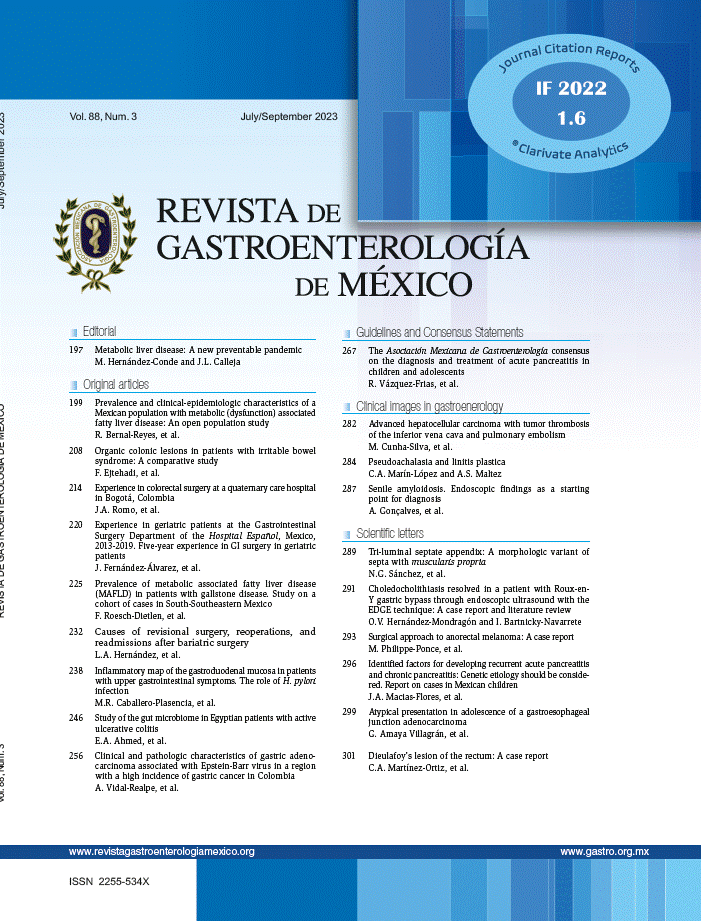Superior mesenteric artery syndrome (SMAS), also known as Wilkie syndrome, is a rare benign cause of mechanical obstruction secondary to compression in the third portion of the duodenum due to a decrease in the angle of the superior mesenteric artery in relation to the aorta. The degrees of angulation and the distance between the superior mesenteric artery and the aorta considered normal are 38° to 65° and 10 to 33 mm, respectively. A distance < 8 mm has 100% sensitivity and specificity, and an angle < 22° has 42.8% sensitivity and 100% specificity for the diagnosis of SMAS. Surgical or endoscopic gastrojejunal anastomosis is an efficacious treatment for SMAS.1
An 18-year-old male presented with perforation of the ascending colon with abdominal sepsis as the first symptom of Crohn’s disease. A right hemicolectomy with ileostomy was performed. The patient then developed hospital-acquired pneumonia and required 21 days of mechanical ventilation. After 4 weeks of hospitalization, he presented with oral feeding intolerance and became severely malnourished, according to the Glim criteria (15 kg weight loss, BMI: 18 kg/m2) and a low level of albumin (1.6 g/dl). A tomography scan revealed a decrease in the angle and distance between the superior mesenteric artery and the aorta (10° and 3.1 mm, respectively), with retrograde gastroduodenal dilatation consistent with SMAS (Fig. 1). He was treated conservatively, with a decompression nasogastric tube, parenteral nutrition, and intravenous prokinetic for 2 weeks, without achieving oral feeding tolerance. In the interdisciplinary clinical discussion, the patient was considered a poor candidate for surgical gastrojejunostomy due to his poor nutritional status, so endoscopic ultrasound-guided gastrojejunal anastomosis (EUS-GJA) was carried out, with no complications. A lumen-apposing metal stent (LAMS), with a 15 mm diameter, was placed utilizing a Hot Axios device (Boston Scientific, Marlborough, Massachusetts, USA). Serial clinical-radiologic follow-up has been favorable, with the patient having adequate oral feeding tolerance, weight gain of 8 kg (BMI: 21 kg/m2), increased albumin level (3.8 g/dl), and improved superior mesenteric artery-aorta angle and distance (27° and 8 mm, respectively). The LAMS has been in place for 18 months with no related complications (Fig. 2).
A) Sagittal view of the abdominal tomography scan with intravenous contrast shows decreased angle and distance between the superior mesenteric artery and the aorta (10° and 3.1 mm). B) Coronal view of the abdominal tomography scan with oral contrast shows the compression at the level of emergence of the superior mesenteric artery and the aorta, with retrograde gastroduodenal dilatation (arrow).
A) Coronal view of the abdominal tomography scan with intravenous contrast 12 months later, with improvement in the angle and distance between the superior mesenteric artery and aorta (27° and 8 mm). B) Gastrointestinal series 6 months after EUS-GJA, with advancement of the gastroduodenal and gastrojejunal media. C) Endoscopic image of the proximal end of the LAMS 18 months later. D) Endoscopic image of the distal end of the LAMS 18 months later.
EUS-GJA: endoscopic ultrasound-guided gastrojejunal anastomosis; LAMS: lumen-apposing metal stent.
EUS-GJA is a safe and efficacious alternative for managing obstructed gastroduodenal emptying, with a technical success rate of 92% (95% CI 88-95%), a clinical success rate of 90% (95% CI 85-94%), and a complication rate of 12% (95% CI 8-16%).2 Most scientific evidence on EUS-GJA has come from palliative management of malignant gastroduodenal obstruction and there is little information in the literature related to EUS-GJA in benign disease. One of the studies with a higher number of cases of EUS-GJA in benign disease reported that clinical success, technical success, procedure time, and hospital stay were similar in both malignant and benign disease cases.3 There are questions regarding the long-term patency and safety of the LAMS in EUS-GJA in benign disease. A recent study that evaluated patients who underwent EUS-GJA in benign disease showed adequate long-term patency of the LAMS, with a median permanency of 286 days (range: 88-1,444 days), even describing 3 patients that surpassed 900 days (944, 1,408, and 1,444 days).4 There are very few reports on EUS-GJA for treating SMAS in the literature.5–9 The present case shows that EUS-GJA is a minimally invasive alternative that has long-term safety and efficacy, in patients with benign gastroduodenal obstruction who are not candidates for surgery and/or have failed conservative treatment.
CRediT authorship contribution statementE. Murcio-Pérez: conception and design, data acquisition, analysis and writing of the manuscript. I. Bartnicki-Navarrete: conception and design, critical review of the content. J.C. Pintor-Belmontes: conception and design, critical review of the content. O.M. Solórzano-Pineda: critical review of the content. O.V. Hernández-Mondragón: concept and design, critical review of the content. All the authors approved the definitive version of the manuscript presented herein.
Ethical considerationsThe present work meets the current bioethical research norms. The authors declare this article contains no personal information that could identify patients.
Declaration of Generative AI and AI-assisted technologies in the writing processAI was not utilized in the present work.
Financial disclosureNo financial support was received in relation to this study/article.
The authors declare that there is no conflict of interest.







